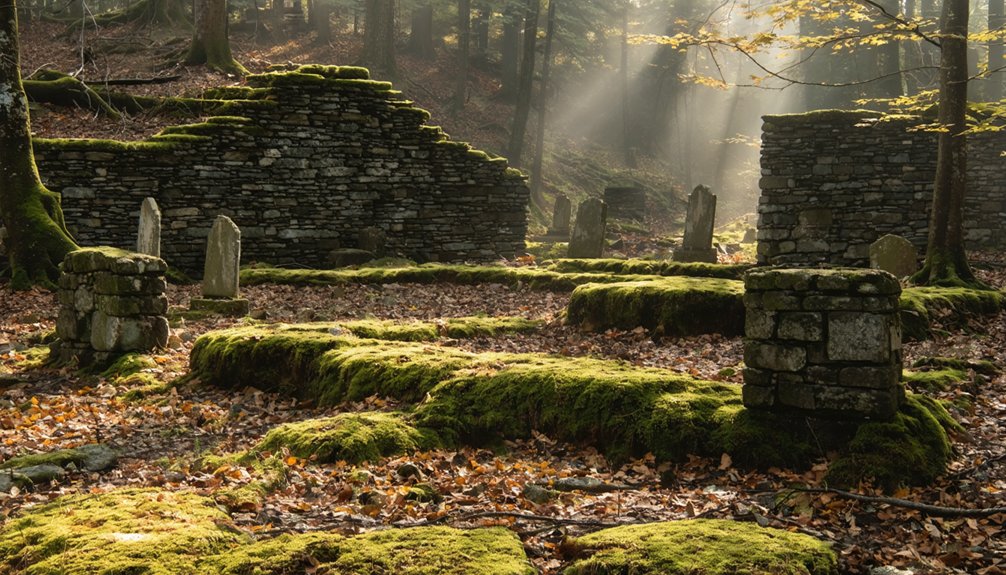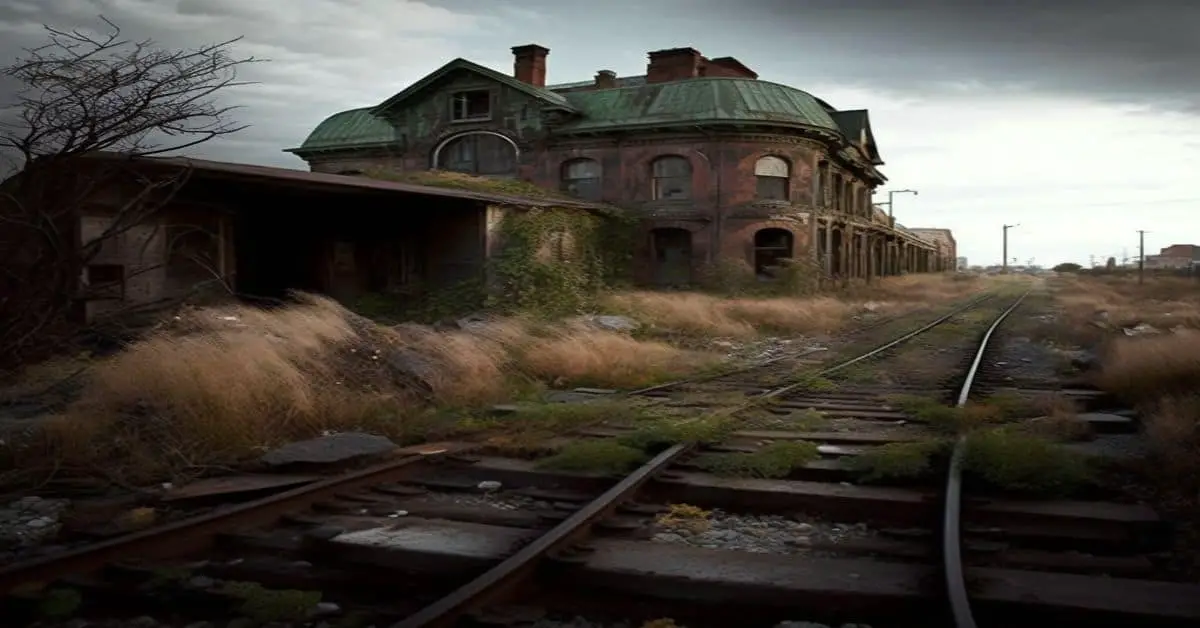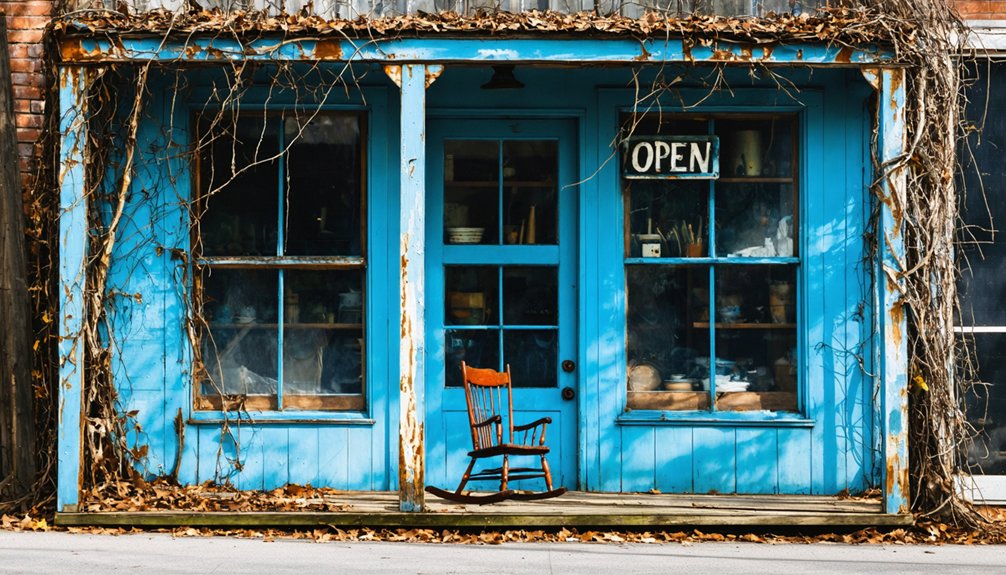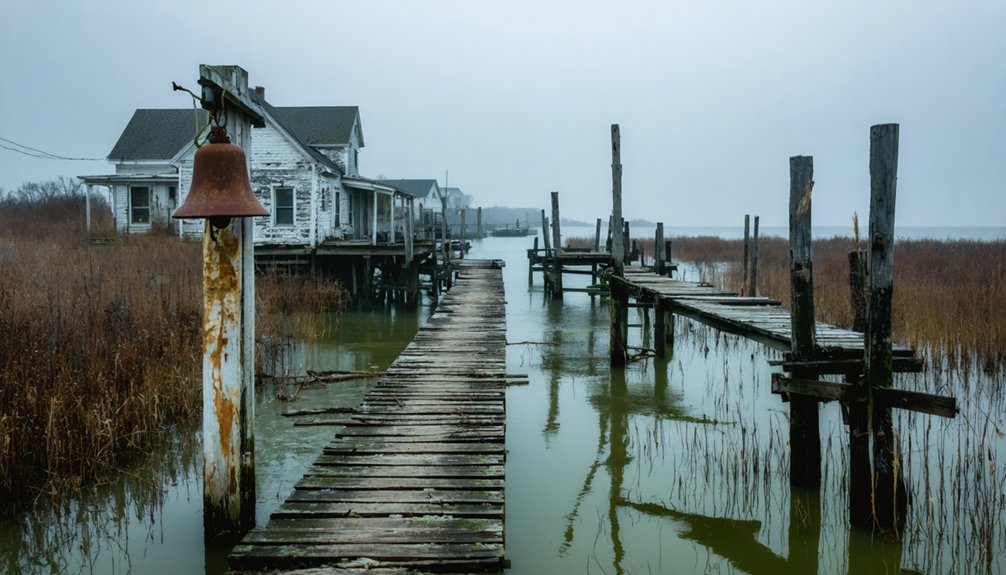You’ll find Bara-Hack, an abandoned Welsh settlement in northeastern Connecticut, established between 1778-1790 by the Higginbothams and Randalls. The mill town thrived on spinning wheel production and grain milling until its gradual decline in the mid-1800s, with the last resident dying in 1893. Today, stone foundations, a cemetery, and mysterious reports of ghostly voices and apparitions make this “Village of Voices” a fascinating piece of New England’s supernatural lore.
Key Takeaways
- Bara-Hack was a Welsh settlement founded in Connecticut between 1778-1790 by the Higginbotham and Randall families.
- The community thrived through water-powered mills, spinning wheel production, and shoe manufacturing before becoming completely abandoned by 1890.
- Notable remnants include stone foundations, cellar holes, an arched stone bridge, and the well-preserved Randall-Botham Cemetery.
- Known as the “Village of Voices,” Bara-Hack attracts paranormal investigators who report mysterious sounds, apparitions, and unexplained phenomena.
- The site is now strictly off-limits to the public, requiring explicit landowner permission for any visits.
The Settlement’s Welsh Origins and Early Days
While the exact founding date remains debated, Bara-Hack emerged as a Welsh settlement in northeastern Connecticut between 1778 and 1790. Two families of Welsh descent, the Higginbothams and Randalls, established this remote community after relocating from Cranston, Rhode Island, likely seeking refuge from Revolutionary War turmoil.
The settlement’s name, “Bara-Hack,” potentially meaning “breaking of bread,” reflects the Welsh traditions and community rituals that defined daily life. Today, only foundations and walls remain as testament to this once-thriving village.
You’ll find that these settlers maintained strong agrarian practices typical of Welsh communities, emphasizing shared resources and communal living. The settlers developed a successful economy through their spinning wheel production, particularly focusing on flax wheels. Though historical records remain sparse and sometimes contradictory, the settlement’s Welsh heritage shaped its cultural identity through naming conventions, farming methods, and community gatherings, creating a distinct cultural enclave in Connecticut’s rugged Ragged Hills area.
Life in the Mill Town: Industry and Community
As Bara-Hack developed into a working mill town, its economy centered around a waterwheel-powered mill that ground grain and powered machinery along the local brook.
Community dynamics revolved around two main families – the Randalls and Higginbothams – who managed most of the settlement’s industries. You’d find cottage industries producing spinning wheels, while George Randall Jr.’s shoemaking shop employed several workers and sold to nearby Southbridge.
Prominent local families, the Randalls and Higginbothams, drove Bara-Hack’s economy through industries like shoemaking and spinning wheel production.
Labor practices reflected the era’s norms, with family members, indentured servants, and enslaved individuals (until Connecticut’s abolition in 1848) working the land and facilities. The enslaved workers often spoke of ghosts in the elm near their burial grounds, creating an atmosphere of mystery around the settlement. The land was originally home to the Mohegan people before James Fitch Jr. acquired it in the 1680s.
The settlement’s isolation shaped its self-sufficient nature, with residents sharing burial grounds and maintaining close social ties. Daily life focused on seasonal work patterns, practical education within families, and communal activities that strengthened their tight-knit community.
The Randall and Higginbotham Legacy
The pioneering Randall and Higginbotham families established Bara-Hack between 1778 and 1790, fleeing from Rhode Island during Revolutionary War upheaval. After escaping the Battle of Rhode Island, the families sought refuge in their newly purchased Connecticut lands. The Randall Heritage centered on their shoe manufacturing and gristmill operations, while the Higginbotham Influence shaped the settlement through farming and textile production. Together, they created a self-sufficient community that thrived for nearly a century. Originally named to honor their Welsh heritage, the settlement became known as Bara-Hack.
- Built and operated a waterwheel-powered gristmill and shoe manufacturing shop
- Produced essential flax spinning wheels for colonial textile needs
- Developed shared community structures, including the now-legendary cemetery
- Created a mixed economy combining agriculture and artisanal manufacturing
The settlement’s decline began in the late 1800s, with Betty Randall’s death in 1893 marking the end of an era.
Though Bara-Hack now lies abandoned, the families’ legacy lives on through local lore and the mysterious tales surrounding their former home.
From Prosperity to Abandonment
Despite its promising start as a prosperous mill town, Bara-Hack’s journey from industrial success to abandonment unfolded gradually throughout the 19th century.
You’ll find that the community’s initial economic significance, centered on flax wheel production and shoemaking, supported robust cultural exchange between local families and nearby towns like Southbridge.
However, economic shifts hit the settlement hard. As markets evolved and younger generations sought opportunities elsewhere, Bara-Hack’s industrial focus narrowed dramatically.
You can trace the town’s decline through its dwindling population, as both the Randall and Higginbotham families slowly disappeared from the area. By 1890, you would’ve found no remaining residents, and Betty Randall’s death in 1893 marked the final chapter of human habitation. Today, visitors are reminded to obtain proper permissions before exploring the abandoned settlement’s remains.
Nature quickly reclaimed the once-bustling settlement, leaving only scattered ruins as evidence of its existence.
Tales From Beyond: Reported Paranormal Activity
You’ll find the most compelling paranormal accounts at Bara-Hack center around distinct auditory and visual phenomena, including voices of former inhabitants, children’s laughter, and unexplained orbs of light above the cemetery.
The reports gain credibility through consistent documentation by paranormal investigators, particularly the 1971 Rhode Island parapsychology students who recorded depression, auditory anomalies, and the inexplicable physical immobility of a team member.
While the bowl-shaped terrain may explain some acoustic oddities, the numerous sightings of apparitions – including a bearded man and a young child – suggest supernatural activity beyond natural explanations. Photographs taken by visitors have revealed peculiar patterns, showing only men and babies in the images.
Ghostly Sights and Sounds
Since its abandonment in the late 19th century, Bara-Hack’s ghostly presence has manifested through a diverse range of paranormal phenomena reported by visitors and investigators alike.
You’ll encounter haunting melodies of wagon wheels on gravel trails and spectral laughter of children echoing through the old settlement grounds. The site’s unique bowl-shaped geography amplifies these mysterious sounds, creating an otherworldly acoustic experience.
- Ghostly apparitions of a bearded man, believed to be Obadiah Randall, wandering near the ruins
- Floating orbs and streaks of light dancing above the cemetery at night
- Unexplained shadow figures moving without touching the ground
- Disembodied voices and sounds of daily settlement life persisting through time
These paranormal manifestations continue to draw those seeking connections to Bara-Hack’s historic past.
Eyewitness Paranormal Encounters
The most compelling paranormal encounters at Bara-Hack began with a pivotal 1971 investigation by three Rhode Island parapsychology students. Upon arrival, they experienced overwhelming depression and heard inexplicable sounds of barking dogs, mooing cattle, and human voices.
During their follow-up visit, one investigator became physically frozen by an unseen force.
These encounters sparked decades of Bara-Hack legends and documented paranormal implications. Visitors have witnessed a bearded male spirit drifting through the cemetery, an ethereal infant resting in tree branches, and mysterious orbs of light hovering above grave sites.
You’ll find consistent reports of phantom wagon wheels on gravel paths and children’s laughter echoing through abandoned ruins. The oppressive atmosphere often triggers sudden anxiety, while some areas produce unnatural cold spots coinciding with paranormal events. Many believe these haunting manifestations stem from the Nipmuc tribe’s curse placed on the land after their forced displacement.
The Cemetery’s Mysterious Phenomena
Located within the abandoned village of Bara-Hack, mysterious phenomena have captivated visitors and paranormal investigators for over a century. The cemetery’s haunting presence manifests through phantom laughter, disembodied voices, and spectral figures that seem to persist from its past.
Since the 1800s, witnesses have reported encounters with a bearded apparition hovering above the gravestones and a ghostly child reclining in nearby trees.
- Unexplained sounds of daily village life, including horse-drawn wagons and livestock
- Bright orbs and streaks of light dancing over burial grounds at night
- Multiple documented cases of visitors experiencing sudden feelings of unease
- Consistent eyewitness accounts spanning generations, including the enslaved individuals of the Randall family
The cemetery’s reputation for paranormal activity gained significant attention after Paul Eno’s 1971 investigation, which documented various supernatural occurrences and was later featured in Fate magazine.
Physical Remnants and Present-Day Access
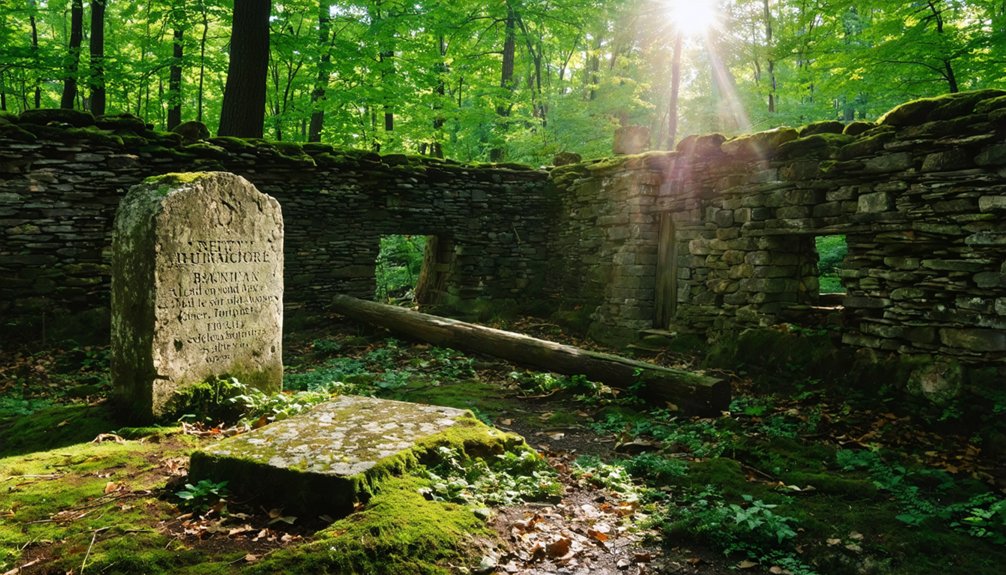
Despite centuries of abandonment, physical remnants of Bara-Hack continue to endure within its forested landscape, offering glimpses into the once-thriving settlement.
The settlement layout reveals itself through stone foundations and cellar holes, while an arched stone bridge spans Bara-Hack Brook, showcasing early architectural features of colonial engineering.
You’ll find the Randall-Botham Cemetery remains the site’s best-preserved landmark, enclosed by stone walls and marked by weathered gravestones bearing the names of original settlers.
While the millpond no longer functions, its ruins hint at the community’s industrial past.
However, you can’t freely explore these historic remains – the site sits on private property with strict access restrictions.
You’ll need direct permission from the landowners for any authorized visits, as they actively protect the site from trespassers.
Notable Ghost Hunters and Investigations
You’ll find that paranormal investigations at Bara-Hack gained prominence with Paul Eno’s 1971 visit, during which he documented spectral phenomena including ghostly voices and unexplained lights.
Modern research teams have since expanded on Eno’s findings, recording mysterious wagon sounds, phantom animal noises, and encounters with unseen forces that physically interact with investigators.
The site continues to draw paranormal groups who report consistent experiences with orbs, apparitions of a bearded man and infant figure, and the distinctive sounds that earned Bara-Hack its “Village of Voices” nickname. Early accounts from the Randall’s slaves first reported spectral activity at the site, describing spirits that appeared in an old elm tree.
Paul Eno’s 1971 Visit
In 1971, paranormal investigator Paul Eno conducted a pivotal investigation of Bara-Hack’s grounds that would cement the ghost town’s reputation in paranormal research.
During his haunted history exploration, Eno and his team encountered several inexplicable phenomena that they couldn’t debunk.
- A bearded face appeared hovering over the cemetery
- Team members found themselves unable to physically move toward the burial ground
- Children’s laughter echoed through the abandoned settlement
- Some sounds remained mysteriously absent from their recording equipment
These spectral encounters weren’t isolated incidents.
The team documented multiple instances of paranormal activity, including visual apparitions and unexplained voices.
Their findings, later published in Eno’s books “Faces At The Window” and “Behind The Paranormal,” provided compelling evidence that would influence future paranormal research at the site.
Modern Paranormal Research Teams
Modern paranormal techniques employed at the site include audio recordings, visual observations, and environmental monitoring to detect orbs and light streaks near the cemetery.
Investigators have reported apparitions of a bearded man resembling settler Obadiah Higginbotham and child spirits linked to the Randall family’s slaves.
However, strict private property restrictions now limit formal research access, forcing investigators to rely on fragmentary evidence and occasional permitted visits to document the site’s persistent paranormal activity.
Preserving Bara-Hack’s Historical Heritage
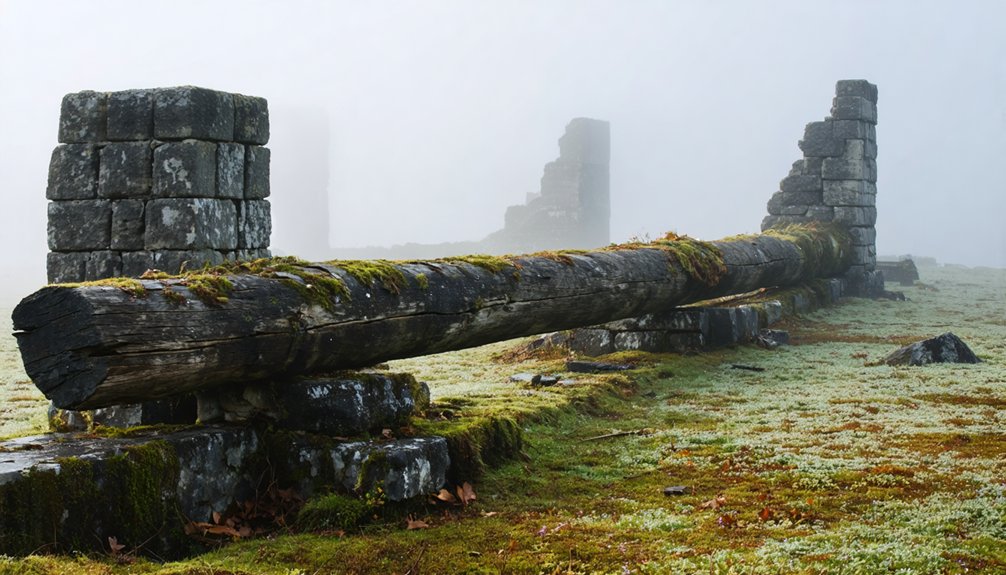
The preservation of Bara-Hack’s historical heritage centers on extensive documentation dating back to the 1780s, when settlers Obadiah Higginbotham and Jonathan Randall first established the settlement. Historical preservation efforts have focused on protecting the site’s physical remnants while maintaining detailed records of its industrial and cultural significance.
Preserving Bara-Hack’s legacy through meticulous records and physical protection ensures this 1780s settlement’s story endures for future generations.
- Original land records, genealogical data, and cemetery documentation provide a thorough timeline of the settlement’s development.
- Archaeological remains include visible foundations and wall remnants that reveal the village’s layout.
- The site remains on private property with strict access controls to prevent vandalism.
- Local historical societies catalog discovered artifacts while maintaining the cemetery’s 19th-century tombstones.
Community involvement in preservation combines factual history with local folklore, creating a rich narrative of Bara-Hack’s past while respecting property rights and archaeological integrity.
The Village of Voices in New England Folklore
You’ll find Bara-Hack’s enduring legacy as the “Village of Voices” stems from over a century of documented reports describing mysterious sounds of daily colonial life echoing through the abandoned settlement.
These ghostly sounds, ranging from children’s laughter to horse-drawn wagons, have been consistently reported by witnesses including Harvard professor Odell Shepard in 1927 and countless visitors since.
The unexplained auditory phenomena distinguish Bara-Hack from other New England haunted sites, where witnesses claim to hear the persistent echoes of its early settlers continuing their daily routines long after the village’s abandonment.
Mysterious Sounds Through Time
Deep within Connecticut’s forgotten Bara-Hack settlement, mysterious sounds have echoed through time since its abandonment in 1890, earning it the haunting nickname “Village of Voices.”
Visitors consistently report hearing distinct historical sounds – from horse hooves clattering on gravel trails to children’s laughter and conversational murmurs – despite no visible source.
These spectral whispers paint an auditory portrait of daily life from the village’s vibrant past:
- Horse-drawn wagons and industrial mill sounds reflecting the settlement’s Welsh roots
- Disembodied voices speaking, singing, and laughing throughout the grounds
- Livestock noises and general village activity from the late 18th century
- Unexplained auditory echoes that intensify near the old cemetery
Paranormal investigators have documented these phenomena extensively, yet no natural explanation accounts for these persistent historical soundscapes that continue to intrigue visitors.
Ghosts of Early Settlers
Among New England’s most intriguing spectral legends, Bara-Hack’s ghostly residents tell a compelling story of the settlement’s original inhabitants.
You’ll find traces of its Welsh heritage in both name and spirit, as the town’s founders, Obadiah Higginbotham and Jonathan Randall, established their mill community around 1780.
Today, settler spirits reportedly manifest in various forms – from a bearded man’s apparition to mysterious orbs floating above the cemetery where Betty Randall was laid to rest in 1893.
Perhaps most haunting is the account of Randall family slaves who witnessed an infant’s spirit in a tree.
While the town’s physical structures have long since surrendered to nature, paranormal researcher Paul Eno’s investigations suggest the original inhabitants haven’t truly left.
Their presence lingers, though the property remains strictly off-limits to curious visitors.
Tales From Local Witnesses
When visitors venture near the abandoned ruins of Bara-Hack, they often encounter an unsettling chorus of mysterious sounds and spectral activity.
These haunted landscapes have yielded countless testimonies since the 19th century, with witnesses reporting everything from ethereal whispers to full apparitions.
Local spectral folklore gained credibility through documented accounts from the Randall family’s slaves, who first reported seeing unidentified figures near the cemetery.
- Voices, whispers, and children’s laughter echo through the abandoned village
- A bearded man’s face appears near the cemetery, believed to be a village founder
- Ghostly orbs and swirling lights hover above the burial grounds
- Visitors experience intense anxiety and physical chills throughout the property
Modern investigators continue to document these phenomena, adding to Bara-Hack’s reputation as the “village of voices.”
Frequently Asked Questions
Are There Any Documented Deaths or Murders at Bara-Hack?
Like autumn leaves quietly falling, you’ll find only natural deaths documented at Bara-Hack, with Betty Randall’s 1893 passing being the last. Despite Bara-Hack folklore, there’s no evidence of murders or violent deaths.
What Happened to the Slaves Who Reported Seeing Apparitions?
You won’t find detailed records of what happened to these slaves after their ghostly encounters. Historical accounts don’t track their fates, though their stories became part of Bara-Hack’s enduring supernatural legacy.
Why Did Other Settlers Not Repopulate the Abandoned Village?
You’ll find settler motivations were discouraged by deteriorating village conditions, economic decline, supernatural stigma, and property restrictions. The isolated location and lack of commercial prospects didn’t attract new investment or residents.
Were Native American Settlements Present in the Area Before Bara-Hack?
Like today’s Instagram hotspots, you’d find thriving Native culture throughout the region. Historical impact shows the Wangunk, Pequot, and other tribes inhabited these lands for 12,000 years before Bara-Hack.
Have Any Artifacts From the Original Settlement Been Preserved in Museums?
You won’t find any original Bara-Hack artifacts in museum exhibitions today. There’s no evidence of formal artifact preservation, as restricted access and private ownership have prevented archaeological collection and curation efforts.
References
- https://astonishinglegends.com/astonishing-legends/2021/3/23/the-ruins-of-bara-hack
- https://digging-history.com/2013/12/04/ghost-town-wednesday-bara-hack-connecticut/
- https://www.damnedct.com/bara-hack-pomfret/
- https://theghostinmymachine.com/2021/07/19/haunted-road-trip-bara-hack-pomfrets-lost-village-of-voices-connecticut/
- https://www.cthauntedhouses.com/real-haunt/barahack.html
- https://en.wikipedia.org/wiki/Bara-Hack
- https://ermakvagus.com/North America/usa/Northeast/bara-hack/bara-hack.html
- https://www.ctpost.com/projects/guides/map-haunted-connecticut/
- https://www.ctinsider.com/projects/guides/urban-legends-connecticut/
- http://www.riseupparanormal.com/connecticut.htm
